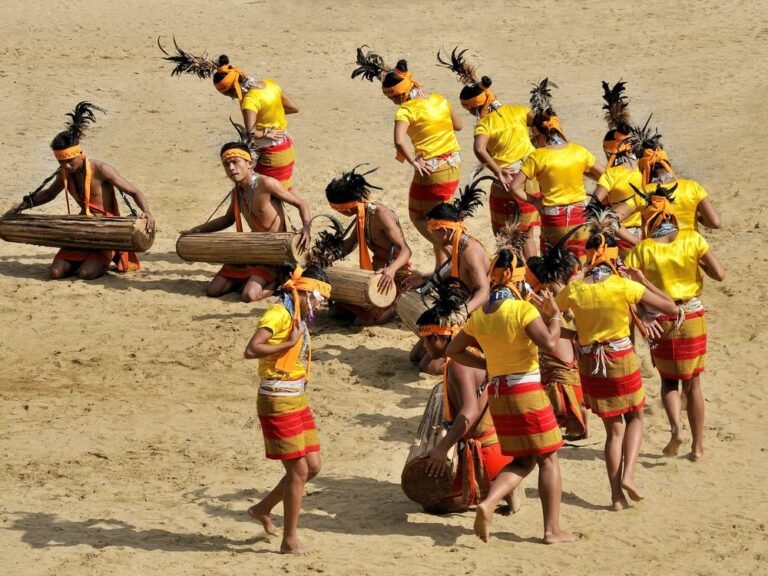Contenus
ToggleIn short
Le festival de Bushu est originaire des États indiens de l’Assam et du Nagaland, au nord-est de l’Inde. Il est pratiqué par le peuple Dimasa-Kachari du Nagaland. L’offrande d’une récolte entière au dieu Dimasa Brai Sibrai Madai est faite pour atteindre la paix. Il est parfois célébré après la fin de la récolte.

Déroulement du festival de Bushu
Le festival est célébré la dernière semaine de janvier. Elle marque le début de la saison post-récolte. Les gens vénèrent Sibrai une fois par an avant de semer le paddy pour la prochaine récolte. Diverses offrandes sont faites à la divinité Sibrai en signe de remerciement. De nombreuses autres cérémonies et rituels sont pratiqués par le peuple. Une porte complexe appelée Phangsla est propulsée à l’entrée du village. Les gens offrent de la viande, des céréales et de la bière à la divinité Sibrai.
Les rituels religieux sont ensuite précédés d’un énorme festin qui est ensuite suivi de la percussion, de la musique et de la danse. Gajaibao, le responsable sélectionné dirige le festival. Les gens travaillent ensemble en harmonie pour préparer une grande fête pour tout le village. Les gens apprécient la nourriture délicieuse lors de la fête. Ils boivent, dansent et chantent aussi. Le festival est considéré parmi les festivals populaires du Nagaland.
Le festival est divisé en trois catégories et la durée du festival varie donc en conséquence. Busu Jidap est observé pendant trois jours. Surem Baino est observé pendant cinq jours. Et enfin, Hangseu Manaoba est observé pendant sept jours ou nuits.
Busu Jidap est originaire de la première catégorie de célébrations qui dure jusqu’à trois jours. Les deux premiers jours sont respectivement appelés mi-staiba et Busuma. Le premier jour, les animaux sont abattus sous la direction de Gaonbura et la viande achetée est utilisée pour le festin. Au crépuscule, des concours de chant et de danse appelés baiba ont lieu.
Le deuxième jour, les enfants et les jeunes rendent hommage à leurs aînés et à leurs parents. Le dernier jour, garçons et filles se promènent dans le village en visitant chaque maison avec de la musique et de la danse pour compagnie. Chaque ménage apporte un jeton ingénieux ou des matières premières qui peuvent être utilisées dans la préparation d’une autre fête.
Surem Baino est célébré pendant cinq jours. Le Gajaibao réside sur le festival. Un Gajaiboa est choisi en particulier pour Surem Baino jours avant la célébration du festival. Il y a très peu de différence partagée par Busu Jidap et Surem Baino. Le festival est célébré dans la cour du Gajaibao chaperonné avec des danses, des chants et des instruments de musique.
Hangseu Manaoba est la plus prestigieuse des trois catégories. Il est célébré pendant sept jours ou nuits. Il est célébré par tout le village qui a beaucoup de jeunes mains à travailler dur pour que les festivités se déroulent pendant sept jours. Pendant ces longues vacances avec un rythme constant et continu de battements de tambour (Khrams) et de trompettes (Muree). Les villageois collectent des fonds avant le festival pour la grande fête. Les célébrations comprennent essentiellement les mêmes : chants, danses et festins.
Social networks
Aujourd’hui, les Kachari du Nagaland commencent le festival de Bushu. Diverses offrandes sont faites à Sibrai pour semer le paddy. De nombreux rituels de danse s’ensuivent durant une semaine. #mythologie #mythe #legend #calendrier #27janvier #bushu #nagaland #kachari
Picture
